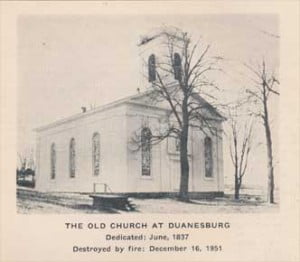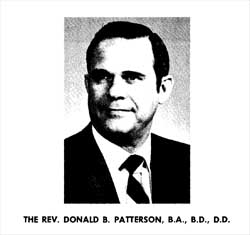The following is a transcript from a news clipping preserved among the Papers of the Rev. Henry G. Welbon, at the PCA Historical Center. [Scrapbook #5, p. 503]. The Rev. Emo F. J. Van Halsema writes in reply to a prior editorial [not available in Welbon’s collection], and the Editor then makes a final comment. Time has proven the Editor wrong, as you will see, and has only confirmed Rev. Van Halsema’s estimations. This is the last of the Machen tributes recently located among the Welbon Papers.
An Appreciation of Dr. Machen.
[from the People’s Forum of The Passaic New Jersey News, 8 January 1937]:—
Editor, Herald-News: — Kindly permit me making a few remarks anent your editorial on the late Rev. Dr. J. Gresham Machen in late Monday’s issue.
When you say that he was a very able, a wholly sincere man, a man of deepest convictions, whose conscience would not allow him to temporize with views he opposed, those who have known him will readily endorse these words. But what you add comes obviously from an unsympathetic pen. The general impression left with the reader is that though Dr. Machen was a capable leader, he was a sadly mistaken one, whose work will now, after his sudden and unexpected demise, come to naught.
This, Mr. Editor, is an attitude which fails to take into consideration the true significance of the movement in which Dr. Machen had so prominent a place up to the day of his death. The point which Dr. Machen for more than a decade tried to emphasize was that the Presbyterian Church in the United States of America should be loyal to its Westminster Confession as long as this Confession had not been officially repudiated. He was, for that reason, hostile to the Auburn Affirmation and consistently pointed out numerous deviations from the official Standards of the Church in publications which appeared under Presbyterian name. All that he persistently asked was that the Church uphold its Confessional Standards. That is the fight he fought. The trials instituted against him sidetracked the main issue. The ecclesiastical authorities frowned upon him for sowing the seeds of suspicion, for opposing the official church boards, for disturbing the peace of the church and finally unfrocked him. Ecclesiastical machinery won a questionable victory. The lonely man of Philadelphia met a glorious defeat.
It has been said by men prominent in the ecclesiastical trial that doctrinal issues had no bearing on the case, that Dr. Machen was free to think about theological matters as he pleased. The truth, however, is that doctrinal matters did enter in. In fact, loyalty to the Westminster Confession has been Dr. Machen’s plea from the beginning. A minister in the Presbyterian Church is not free to teach what he pleases. Dr. Machen held that he was bound by the Standards and that the Church was too. His many attempts at reform were of no avail. The doctrinal issue loomed up everywhere. It was the heart of the entire controversy, yet, it was consistently and conveniently sidetracked.
In June, 1936, the Presbyterian Church of America was organized to continue “true Presbyterianism.” This was a bold act. It was an act born of need. Dr. Machen did not seek his own martyrdom. The Assembly at Syracuse force it upon him. Said the Doctor, “We have made every effort, in accordance with our solemn ordination pledge, to bring about a return from modernism and indifferentism to the Bible and to the Church’s constitution. Those efforts having proved unavailing, we now are continuing true Presbyterianism in the Presbyterian Church of America. We are not ready to take the Bible off our pulpits and put the last minutes of the Assembly in its stead.” Organizing the new Church was an act of faith.
Your prophecy, Mr. Editor, that what you choose to call “the off-shoot sect” has reached its zenith and will now decline, is but a mortal man’s prediction. You spoke of Dr. Machen’s martyrdom. The Church willingly acted as executioner. We recall that the blood of martyrs has been before this, the seed of the church. Concluding your article you quote the words, “Man proposes, God disposes” in application to Dr. Machen and his movement. Does this not also hold true with uncomfortable consistency of the Church who tried to silence the voice of one of its “terrible meek”? I do not possess the gift of prediction, but the facts are that in the last five months the young sister church gained 69 ministers , making a total of 103, who are working in 23 States and five foreign Countries. The young church today is sad but does not despair. We read, “The cause which he espoused has suffered a terrific blow. But let no one assume that it is a blow of defeat. Those who are left must carry on the tremendous task, as he would have wished them to do. The road will be lonely and the burden of grief heavy, but the work will go on.”
When you state, Mr. Editor, that all Presbyterians wish to forget about the Machen episode, your wish is evidently the father of the thought. Thousands of Presbyterians and other Christians will never forget the sad proceedings of a Church against one of her truest servants who rose to the defense of a Constitution which was slowly being undermined. The Presbyterian Church of America will be a constant reminder to the mother Church of the sad breach among her children in 1936.
The following words written a few days before his death do more justice to Dr. Machen than your editorial. : “He has been bitterly reviled by enemies of the gospel and by many who pretend to love the gospel, but those who know him well and love the gospel dearly regard him as a profound scholar, a veritable Greatheart, a Christian gentleman, a devout child of God, a convincing teacher and preacher, a man with convictions strong as Gibraltar and courage indomitable as Luther’s at the Diet of Worms. It may be said without fear of contradiction that today there is no more scholarly and militant defender of the historic Christian faith against the onslaughts of liberalism than Dr. Machen.”
His voice is now silenced.
His work will go on.
The hammers break, the anvil stands.”
Rev. Emo F. J. Van Halsema
Pastor, Northside Christian Reformed Church
Passaic, January 6.
[With all respect, may we reply to the Rev. Mr. Van Halsema that our feeling was one of sympathy and our desire was to express it. We can express here no opinion as to the doctrinal questions which undoubtedly did enter, and which are not now ended because he has died. The contest between what is called Fundamentalism and what is called Modernism will continue unabated, and it is of course our opinion only that the particular movement, headed by Dr. Machen has reached its zenith and now will decline. We have many examples in history, but do not wish to insist upon it. In justice to the Presbyterian Church in the United States of America (of which we are not a member) it should be pointed out that its proper jurisdiction held officially that there was no rampant Modernism in the Church as charged by Dr. Machen, and that his official condemnation rests almost entirely upon the fact that without authorization he organized an Independent Board of Missions, which appealed for Presbyterian funds, and refused to disband it or dissociate himself from it when commanded so to do by the General Assembly. — Editor Herald-News.]


